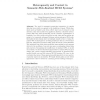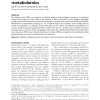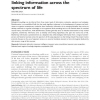252 search results - page 26 / 51 » Using OWL to model biological knowledge |
IJCNN
2006
IEEE
14 years 2 months ago
2006
IEEE
- Gene regulatory networks allow us to study and understand genes’ roles in biological processes. Among others, regulatory networks help to identify pathway initiator genes and t...
OTM
2009
Springer
14 years 3 months ago
2009
Springer
The need for semantics preserving integration of complex data has been widely recognized in the healthcare domain. While standards such as Health Level Seven (HL7) have been develo...
BIB
2006
13 years 8 months ago
2006
Flux balance analysis (FBA) has emerged as an effective means to analyse biological networks in a quantitative manner. Much progress has been made on the extension of FBA to incor...
ATAL
2007
Springer
14 years 23 days ago
2007
Springer
From a multiagent viewpoint, a workflow is a dynamic set of tasks performed by a set of agents to reach a shared goal. We show herein that commitments among agents can be used to ...
BIB
2007
13 years 8 months ago
2007
Biological knowledge can be inferred from three major levels of information: molecules, organisms and ecologies. Bioinformatics is an established field that has made significant a...



